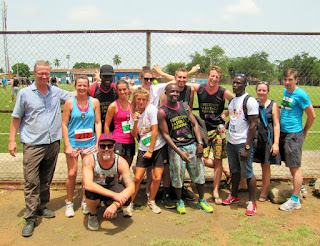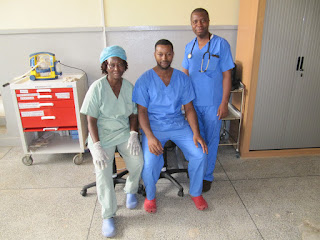Tuesday 13th September 2016.
The bay is calm this morning;
rusty fishing trawlers are floating at anchor dwarfed by ships heading into the
estuary towards the East part of town ready to unload their cargo. I watch from my balcony as a small boat sets
out across the water towards the opposite coast line, ferrying passengers over
to the airport. In the street below a
dog lies curled up in the shade, protected from the early sun’s rays by the
overhanging roof of a nearby wooden shack.
A cockerel crows from the yard next door and a chicken struts past the
gate, pecking idly at the ground until it erupts into a flurry of flapping
wings, barely escaping the wheels of a passing 4 x 4. Freetown is waking up, it is my last day and
I realise the last time that I will look out over this view. It is time to head home and say goodbye to
the city that has charmed me and tested me in so many ways over the last 12
months.
I arrived last September in the
midst of severe flooding, a country still at the tail end of an epidemic and
struggling to recover, now hit by further devastation. The hospital faced a major incident,
compounded by a staffing crisis, as many doctors were sent to care for
displaced families temporarily sheltered in the National Stadium, where all
sport had been suspended for the last twelve months. The hospital coped that day and continued to
provide a vital service to the sick and injured patients, as it had done
throughout the epidemic, due to dedicated staff and strong team work.
King’s Sierra Leone Partnership
had played a significant part in the Ebola response alongside the Ministry of
Health and Sanitation and Connaught Hospital and I admit to being a little in
awe of some of my team members and Sierra Leone staff that had demonstrated
such dedication and courage at the height of the epidemic. Even now I get emotional when I listen to
them discuss some of their experiences, especially my colleague Marta. Although my main role was focused on
developing the Emergency Department, the small team of clinicians were still
providing an on-call rota to cover the hospital’s isolation unit. I remember the butterflies in my stomach and
sweat trickling down my forehead the first time that I went through the
decontamination process to remove my personal protective equipment. I was keen to ensure that I followed each of
the 25 steps in the process to the letter.
KSLP A&E Team December 2015: Ling, Hedda and myself
King's House residents October 2015
On November 7th, the
country was declared Ebola free and although it was to flare again
subsequently, this was a momentous day in the history of the country and was a
reflection of a collaborative effort between the government of Sierra Leone,
the healthcare workers and international organisations to contain the
disease. Effective case management,
community engagement and strict infection control practices eventually brought
the situation under control and has highlighted the precarious and weak nature
of the health system. It is hoped that
one of the positive legacies of this terrible period is a focus on health
system strengthening and resilience to deal with emergencies. Work is already underway as part of the
President’s Recovery Plan. It was
humbling to be on the streets amongst the crowds that night and a privilege to
play a small role in the subsequent recovery process.
Candle light vigil 7th November 2015
The main component of my role was
to assist in development and strengthening of the Emergency Department at
Connaught Hospital, the main government referral centre for the country. This is an ongoing project that King’s have
been involved in since 2013 when the partnership began in-country and the first
6 months were spent working with my dedicated colleague Ling. Funding had been secured through DfID to
refurbish the department in partnership with the hospital staff and management
and the aim was to transform what had been the original make-shift isolation
unit back into a new fit-for-purpose Emergency and Acute admissions unit. I learnt a great deal from Ling about how to
get things done and I have no doubt that the success to date is due to the work
that she did with hospital management, ministry and the team in London
developing the project. In addition, she
gave me the job so clearly has an eye for talent!
Without doubt, the most difficult
aspect of leaving the UK for a year was saying goodbye to my girlfriend and
family. I have always been very
independent and was surprised to find myself struggling with the separation in
the first few months; I suspect that this was delayed onset emotional maturity
and a stronger appreciation of what is important in the long term. I spent Christmas in Freetown but returned
home for a week in January; although brief, this was a significant week in my
life as I found that my sister was pregnant with my first niece and I decided
to make plans to propose to my girlfriend.
A month later, in the mountainous jungle of the Peninsula National Park
above Sierra Leone’s Atlantic Coast, she made me very happy and said yes.
The week of Alice’s visit in
February was a welcome respite before the real hard work began. Ling’s
departure coincided with the opening of the new Emergency Department and
resuscitation room. It was the first
time that I felt real pressure and responsibility to deliver on a major project
for the hospital and organisation that would impact on the health of thousands
of patients across the city. In addition
to this, we were launching an extended pilot program to provide emergency free
health care so that critically ill patients did not have to wait for family to
find money and buy vital medication. As
a result of the careful preparation, the actual move and opening went amazingly
smoothly and the staff that did all the hard work appeared far less stressed
than I did.
A few months later, renovations
were also complete on the other side of the department and we were able to
complete the work by opening the major trauma and surgical admissions
unit. All this work was carried out in
conjunction with local partners and it was immensely satisfying to see the
department finished and the care of patients improving as a result of system
strengthening in coordination with better facilities and environment. From a personal point of view, I have
developed skills in logistics, building design and plumbing that were never
covered in medical school and which I feel will be much more useful in future
life than knowledge of the life cycle of a tape worm.
Rather than winding down over the
final couple of months, time seems to have accelerated as I have continued to
support the Emergency Department as well as pursue other projects including the
development of Early Warning Scores for sick patients with my hard-working
intensive care colleague Ruth and some trauma strengthening work with the
surgical team. I briefly took on the
role of clinical manager of the team for my last month and gained an insight
into the challenges of balancing clinical responsibilities with organisational
priorities whilst looking out for the wellbeing of team members- a daunting
task for which I was pleased to hand over to a reassuringly capable colleague.
The last week has been about
saying goodbye and handing over as well as organising a very wet trip to Bunce
Island Monument which enabled some reflection on the history and heritage of
the city I have spent the last year in.
I am not someone who enjoys public attention or speech making but I have
watched many of my good friends and colleagues say their goodbyes over the last
year and each time it got a little more emotional as I knew them more and I
became aware that my time was approaching.
So I duly stood and said my farewells, to the hospital staff that I had
shared so many experiences with and to my King’s colleagues, some old friends
and some new enthusiastic team members.
Crossing the estuary to Bunce Island and one of the island's former slave fortresses, now being reclaimed by the forest
The highlights of my time in Sierra
Leone have been forming relationships with the staff and getting to know and
work with so many Sierra Leoneans, who have been warm from the start in their
reception, welcoming and ever-friendly, despite my limited ability to learn the
Krio language. It is perhaps clichéd,
but true none-the-less, to say that they are an inspiration and their
dedication to their work in often challenging circumstances will serve as an
example to me for the rest of my career.
It is too early to adequately
reflect on the enormity of what I have learnt and experienced in the last year
but I believe that my future will be shaped and impacted positively from my
time in Freetown and I hope that I may maintain my links and return one day to
see the results of all the re-building and improvement that is occurring in the
country currently.
Thursday 15th
September
I look out onto a different estuary, 3000 miles away. It is a warm day in Liverpool and the Mersey
has a calm blue sheen to its surface.
Life continues in Freetown and it is just another day for my colleagues
in the hospital. For me, it’s a new
direction, just as exciting but very different.
If the idea of having your own Sierra Leone experience excites you, why not apply to volunteer with the KSLP team. More info is available at http://kslp.org.uk/get-involved/volunteer/
If the idea of having your own Sierra Leone experience excites you, why not apply to volunteer with the KSLP team. More info is available at http://kslp.org.uk/get-involved/volunteer/




















































